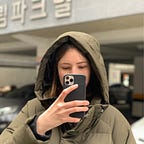06 | Macro UX: Go!
Design a way for people to experience The Hoffman Centre collections.
Group members 🤝: Kate Chernysheva, Qendresa Selimi, Tatiana Bohsali and Maria Shuttleworth
<<< For my previous post, 05 | Macro UX, click here.
Immediately after the presentation last week, I drew up my thoughts and we discussed our feedback as a group.
We made it a priority to solidify our visual identity, and concentrate on the AR: its structure, trails between points, and your position in regard to the information.
We decided the make the AR compliment the website instead of act as its own experience. This allows you to pick up from where you left off on the site and continue in AR. Initially we had wanted to build the AR feature into a working Wix website, but decided it would be best to stick with a Figma prototype for now. However, we still wanted the AR to be a working QR code that the class could view and interact with.
The personal library feature (based on the node-link diagram we made last week) is where you find your own curated collection of articles and media that you can save by clicking on a paper place icon. These articles then show up as coloured dots in the library, where you can zoom in for more detail. We thought this was the clearest way of displaying a large amount of information all at once, so we made it its own page — something the user could return to after browsing.
We then divided tasks. Kate and Tatiana focused on the AR and Qendresa and I on the website.
We wanted to bring out the globe and paper plane metaphors in the site. We had neglected them last week and the class missed them, so what could we do other than bring them back? They are once again a big part of the imagery, with the rest of the UI being clean and simple.
When it came to prototyping the whole team jumped on board and helped out. Prototyping got a little confusing at points but we figured it out, although it still looks very overwhelming from afar.
Meanwhile, the AR was coming along nicely. The video below shows the progress from static dots to clickable planes that spin, with articles that appear above each one. The way we envisioned this working was to have the articles lead you to the corresponding webpage once clicked. You would be able to scan the code at any time to view where you are in the website within the AR layout, and continue your search from there. Sadly, we did not have enough time to implement this but we inferred it as a next stage of development.
Here is the QR code for the AR (sadly only works on iOS with Adobe Aero installed).
Presentation feedback.
We begun by revisiting our process leading up to the final week, discussing our research and ideas we had along the way. We explained that we had considered developing a forum as the end of the experience, but instead decided that this would not add as much value as developing other parts would. Applied Works commented that the forum would be an interesting part to develop if this had been a longer project, taking it beyond where we are now into a more complete experience. They also commented that the personal library has a lot of potential and they would love to see is as a shareable feature.
Many people liked the experience of ‘living’ surrounded by information in your own room, considering AR a good add-on to the experience. Although it added some technological flourish, as it currently stands it is only compatible with iOS. This was due to software restrictions but it is something we would want to think about if it would have been a longer project.
Finally, John commented that we were a good example of close collaboration, managing the process of team working and task delegation well. He added that we responded really well to feedback, addressing all the snags in the project quickly. This was a relief to hear as we had worked hard to develop our project since the feedback last week and it was great to hear that we had progressed well, addressing criticism. Both John and Al said that they have observed us really making an effort, resulting in us making a really coherent portfolio piece.
We were all really pleased to hear the positive feedback as we were very nervous about the final presentation. Although we recognised that there were still some things that need ironing out, we could not have been happier with the feedback and our outcome. I was very lucky to have worked with such a friendly and hard-working team, and I would do it again in a heartbeat!
For the next project, 01 | Micro UX, click here. >>>
